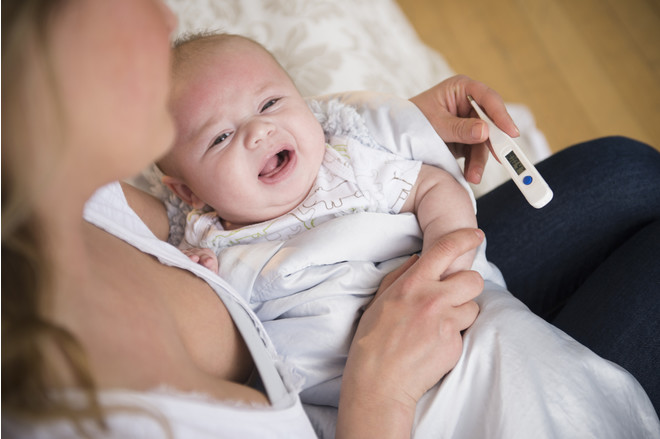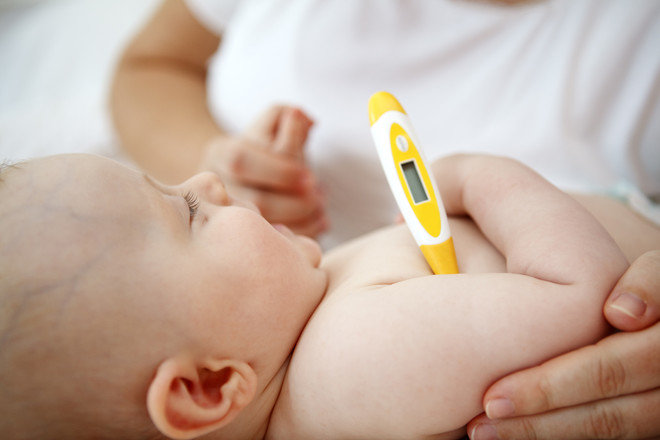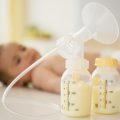Do not panic! Woman's Day gives detailed instructions on how to act if the baby has a fever. Photo: Getty Images
Photo: Getty Images
How to measure the temperature?
If you think your baby is hot, don't jump to conclusions. First, measure your baby's temperature correctly.
- It is desirable to have a separate thermometer for the child (you can buy a special children's).
- Before use, do not forget to wipe it with alcohol or a damp cloth.
- When the kid is scared, excited, fussy, breaks out, do not forcefully measure the temperature, let him calm down a bit.
- Do not measure the temperature under the blanket: if the child is wrapped up, the body becomes very hot.
- It is advisable that you know what the normal temperature of the baby is when he is healthy. In children, it can vary, and in the first year of life in general be slightly elevated (37.0-37.4 ° C).
Temperature can be measured in several ways:under the arm, in the groin, in the ear, in the rectum and in the mouth. Keep in mind that different thermometers are used for this, and each place has its own “healthy” temperature. For example, rectal temperature is 0.5 degrees higher than oral temperature and almost a degree higher than armpit and groin temperature. Therefore, to know for sure how hot your baby is, measure in the same part of the body each time.
When should I give antipyretics?
World Health Organization (WHO)recommends giving your child an antipyretic if you see 39⁰C on the thermometer. Russian pediatricians often say that it is worth bringing down the temperature already at 38⁰C. Here you need to look at the baby's condition: if he has strength, he wants to play and the temperature does not cause him much discomfort, you should not immediately rush to the pharmacy for an antipyretic. But keep in mind that if the child has previously had convulsions against the background of an elevated temperature, he suffers from neurological diseases or he is not yet two months old, do not wait until the temperature reaches its peak, give the medicine. Children's antipyretics are produced on the basis of either paracetamol or ibuprofen. Usually pediatricians recommend starting with the first. If there is no effect, resort to the second. For younger children, it is better to use an antipyretic drug in the form of suppositories (it is also prescribed if the child is vomiting), for older children - in the form of syrup. Never give aspirin to children! At the age of up to 12 years, it can cause serious complications. And forget about analgin! It can cause allergic reactions leading to anaphylactic shock Photo: Getty Images
Photo: Getty Images
How else can you bring down the temperature?
If you don't want to risk giving your baby an antipyretic before the doctor arrives, there are still a few ways to help lower the temperature.
- The child must be provided with coolness. His room should be ventilated, and the air temperature should be at the level of 20-21 degrees. It will not be superfluous to buy a humidifier or put a jar of water in the room where the child is. Do not wrap your child with fever! Dress it easily and do not cover with a warm blanket.
- It is necessary to give the baby a lot of fluids, becausewhen dehydration occurs. If the child is very small, often attach to the chest, more adult children offer diluted juices, compotes, water.
- Additional means for lowering the temperature- wiping. Wet in a warm water cloth can be put on the forehead of the child, also gently wipe the child's body, starting with the handles and legs. But remember that alcohol picking up is the last century. It can give the opposite effect by raising the temperature! In addition, alcoholic vapors are harmful to the baby.
Remember that a child’s fever isthis is a reason to call a doctor. Even if you are sure that the fever will soon subside and the baby will recover, do not be lazy to contact a doctor, because we are talking about the health of the child. Read also:









